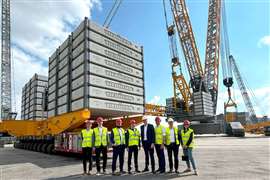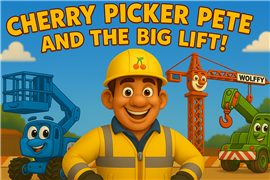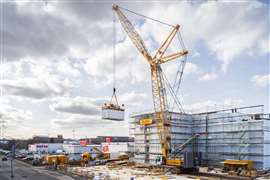The big benefit of self erecting tower cranes
17 August 2023
Self erecting tower cranes are rising in popularity due to the ease that they can be assembled quickly in restricted city spaces. Niamh Marriott reports.
Self erecting tower cranes are traditionally popular in mainland Europe but other territories are now beginning to take note.
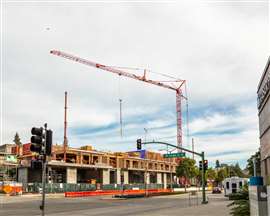 A self erecting tower crane has a relatively small footprint, leaving room for other activities and helping in reducing obstacles and clutter at a job site. (Photo: Bigge)
A self erecting tower crane has a relatively small footprint, leaving room for other activities and helping in reducing obstacles and clutter at a job site. (Photo: Bigge)
Nicola Castenetto, business line director, Terex Tower Cranes, explains, “Germany and Central Europe are definitely key markets, and self erecting tower cranes are pretty common in France and Italy, too. There is also some good activity from our colleagues in North America, like Potain for example.
Clemens Maier, product manager, Liebherr Tower Cranes, agrees that the crane type’s popularity is expanding beyond Europe. “The most common market for self erecting crane is Central Europe. I would say 80 per cent of all self erectors are used in France, Italy and Germany. Outside of Europe, it is quite hard to be successful with these crane types. It’s a very centralised market but we have had some sales in North America.”
“The main obstacle is the road transportation limitations in other countries to bring self erecting cranes on roads. Cranes nearly always require special transportation. You need a special commission and that costs a lot, takes time and requires effort. So it’s hard to convince people in other countries.”
USA-based crane rental company Bigge has supplied self erecting tower cranes for more than 10 years. While not suitable for every job site, the company says that a self erector matches very well with needs that are consistent with the most popular residential building techniques used across the country.
Some of the deciding factors in the selection of a self erector for a project boil down to costs, Bigge says. The Potain Igo T85 is known for its efficiency in setup and operation. Delivered on four or five trailers, depending on the final configuration, the use of a self erector eliminates the need for a dedicated foundation, saving time and money on material costs and streamlining the engineering of their installation. This is in direct contrast to a tower crane built on anchors in concrete that are integrated into a larger foundation. A self erector can also be installed without an assist crane, instead relying on a much smaller piece of equipment, like a telehandler, also contributing to savings on installation.
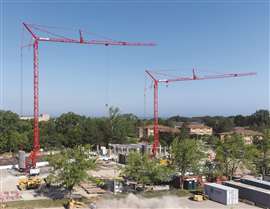 Dawes Rigging & Crane Rental, a member of the All Family of Companies in the USA used two new Potain Igo T 99 tower cranes to build a new student residence hall in Wisconsin. The T 99 is a versatile telescopic self erecting tower crane with a 6.6 US ton capacity, 157 foot reach, and 126 foot height under hook. Its compact transport dimensions, small footprint, and innovative unfolding procedure make it easy to deliver to jobsites and erect in tight quarters. (Photo: ALL)
Dawes Rigging & Crane Rental, a member of the All Family of Companies in the USA used two new Potain Igo T 99 tower cranes to build a new student residence hall in Wisconsin. The T 99 is a versatile telescopic self erecting tower crane with a 6.6 US ton capacity, 157 foot reach, and 126 foot height under hook. Its compact transport dimensions, small footprint, and innovative unfolding procedure make it easy to deliver to jobsites and erect in tight quarters. (Photo: ALL)
Of course, the scale of a project influences the selection of one type of crane over another. Self-erectors typically have a maximum capacity under 10 tons, compared to some of the higher capacity towers that reach the 40 ton range. Among the type of construction where self erectors are found most frequently are low-rise residential developments, using primarily wood frame construction techniques. They are commonly used to unload prepared framing materials transported to a job site, which are restacked and stored on-site before their assembly by carpenters and other laborers.
“We’ve had great success providing self-erectors to our customers,” said Jesse Sullivan, Bigge’s director of tower crane and hoist rentals. “For the right project these cranes are an excellent match to a jobsite’s needs. Our fleet consists of Potain self erectors and has proven extremely reliable. We’ve done just about every kind of installation: rolled in on a trailer, fly in with an assist crane, on podium, dirt, pavement, cement, you name it.”
Clemens Meier continues, “We have never seen the rise of the self erecting crane in China. I saw a couple when I visited a trade show in China a few years ago but I have never seen them twice. I think it is a niche, and currently quite European, market.”
Educating the industry
Castenetto adds, “There needs to be a bit of education around the value that self erectors can bring, and explaining why this crane type works better than telehandlers.
Julian Dyer, sales manager at Falcon Tower Cranes in the UK says implementation of self erectors is a challenge, and telehandlers remain popular as the pre-planning is easier. “When you use a crane, you’re then asked to put bases in place, sign off the ground conditions, have lift plans, etc,” he says. “So it’s quite complex and it frightens a lot of people. You can see the benefits of self erectors once they’re on site, it’s environmentally friendly, uses less fuel and doesn’t damage the ground. You can build the project as you want to build it. You’re not dictated to by access. With a telehandler, you have to reinstate the ground and you could cross-contaminate into the local environments as well because of vehicle movements. We say to our customers, you are under pressure to be more environmentally friendly, you are under pressure to be safer – these are the benefits of self erectors.”
“We’ve spoken to a lot of customers who like the idea but when it comes down to it, they default back to the telehandler. We’ve really got to keep pushing that and hopefully through legislation and trends, and making people feel more responsible, we will get the self erector out there more,” he adds.
Clear benefit
So is the telehandler really the enemy of the self erector? Dyer isn’t convinced, “I think it’s about using the right piece of equipment to do the job. We’re never going to replace the telehandler, but when you look at the numbers that are out there and the numbers in values of sales globally, I mean, we couldn’t make enough self erectors anyway to do that. It’s just getting it in the right place where really there is a clear benefit.”
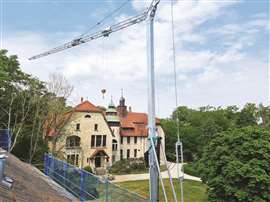 To support roofing work on a job in Germany, BKL provided a mobile fast-erecting crane with a maximum radius of 27 metres from the BKL System Cattaneo. With a maximum capacity of 2.5 tonnes, and 700 kilogrammes at the end of the jib, a CM 271S1 was the best crane solution for the customer. Thanks to its fixed axle, the roofing crane is very mobile. This made it possible for the BKL team to transport the crane efficiently across meadows and fields as well as slightly sloping terrain to the construction site. (Photo: BKL)
To support roofing work on a job in Germany, BKL provided a mobile fast-erecting crane with a maximum radius of 27 metres from the BKL System Cattaneo. With a maximum capacity of 2.5 tonnes, and 700 kilogrammes at the end of the jib, a CM 271S1 was the best crane solution for the customer. Thanks to its fixed axle, the roofing crane is very mobile. This made it possible for the BKL team to transport the crane efficiently across meadows and fields as well as slightly sloping terrain to the construction site. (Photo: BKL)
A self erecting tower crane has a relatively small footprint, leaving room for other activities and helping in reducing obstacles and clutter at a job site, says Bigge. Despite occupying a modest capacity range, self erectors can still deliver materials at a wide radius. Operating from a single fixed position, these cranes can easily and efficiently reach all parts of a job site. This long reach reduces or eliminates the need for multiple pieces of machinery.
Jörg Hegestweiler, CEO at BKL Baukran Logistik in Germany, says there are new applications where self erectors can be used. On smaller construction sites in Germany, where the height under hook is less than 3 storeys, the self erector could be a disruptor to smaller city cranes and be ideal for use. “The cost of transporting a top slewing crane versus a self erector is a big advantage,” he says. “A self erector needs just one or two transports. The top slewing crane needs three, four, even five transports plus erection, plus the mobile crane.”
“What is difficult, or more becoming difficult at the moment, is the road restrictions, but this is also affecting top slewing cranes.”
Perfect size
Liebherr’s 125 tonne-metre rated 125 K fast erecting crane has been specially developed for civil engineering requirements such as road traffic bridges and commercial as well as industrial building construction. But this is the upper limit for self erectors. It’s not just transport issues that restrict the size. Meier says, “If you make the crane much bigger you need you have a bigger footprint, you need extra counterweight, a disadvantage the customer will not accept.”
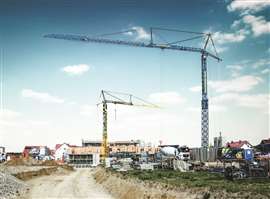 The 125 K from Liebherr offers various hook heights so it can be flexibly adapted to conditions on site. (Photo: Liebherr)
The 125 K from Liebherr offers various hook heights so it can be flexibly adapted to conditions on site. (Photo: Liebherr)
Terex is also looking at the size of self erectors. Castenetto says, “It’s not only a matter of the market, but it’s also that ourselves that have placed renewed focus on the product. That’s why we are looking at developing a new 47 metre jib crane to meet the demand from the market.”
The key arguments for self erectors over telehandlers, crawlers or mobile cranes? Meier explains, “The big advantage for the self erector is its very small footprint, it can be assembled in a couple of minutes, and you don’t need extra staff operating. Cost efficiency and performance on the construction site and time saving for the duration on the project would be the biggest benefits for self erectors.”
Hegestweiler agrees, “The timing on maintenance is important. The footprint is important, too. The easy handling, you have the one piece concept, so you have one machine automatically erected by one service engineer so it’s relatively quick”.
Castenetto continues, “I do love the environmental aspect of self erectors. The fact that you’re not having some stinky machine on the job site. You’re also reducing the number of pieces of equipment working the job site, and you can precisely place the loads. It’s really also different from top slewing cranes. You’re not leaving anything behind, so you don’t need the foundations, making it more environmentally friendly.”
Self erectors bring ecological advantages, agrees Bigge. Without a loud engine, the crane produces no exhaust and helps maintain sound levels well within common sound ordinances. Since the crane is deployed without a foundation, a self erecting tower crane leaves little to no trace of its presence after a deployment.
Dyer says, “I think the only limitations is the technical requirements maybe not being attractive enough to the smaller builders or contractors. In the future, I hope the only limitations are the number of these cranes that you can actually produce within the market.”
Jörg Hegestweiler thinks there’s scope for even bigger self erecting tower cranes than what is currently being offered. Nicola Castenetto says it has to make sense economically, “there is no point putting a crane out which costs more than a top slewing crane.”
Fully automatic
Meier foresees a potential change from semi-automatic to fully automatic models of this crane type. “We see a trend towards more automation of the erection process, which would offer more control,” he says. Yet he’s not sure if operators are ready to relinquish full control. “They want to have the manual work done by the machine, but retain the control of the machine.
“As a manufacturer you have the responsibility regarding safety, and that is complicated with a fully automatic erection process. I don’t see a big demand for fully automatic process yet, and it would make it more expensive.”
Fleet expansion
Julian Dyer says, “With some of our customers we’ve put some large self erectors in places where traditionally they use the top slewing crane, so it cuts down on ground preparation. You still have to do it, but not to the same extent. And the speed of erection is much faster.”
“We run the top slewing and the self erecting divisions operationally, separately. They do use technicians from either side because of the commonality of the technology in the systems. But you do need people that understand the self erectors to be able to run them efficiently and properly. So there are differences. Maintenance is higher on the self erector because it’s more akin to a mobile crane where it’s folding and unfolding. But again, commonality of systems means you can use those skill sets across both ranges.”
Crane lifespan
In terms of economic returns and second life, it’s a relatively comparable score between the self erectors and top slewers.
Hegestweiler adds, “I would say you can compare it quite well depending on the brand, depending on the machine size. The biggest market value at the moment is definitely on the big self erecting machines. There’s a good market, but the disadvantage is you don’t have a worldwide market. We already mentioned the restriction in terms of the market but we have other restrictions in terms of electrification.”
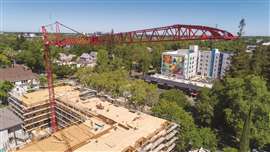 Since the crane is deployed without a foundation, a self erecting tower crane leaves little to no trace of its presence after a deployment. (Photo: Bigge)
Since the crane is deployed without a foundation, a self erecting tower crane leaves little to no trace of its presence after a deployment. (Photo: Bigge)
There’s not a huge appetite for second hand refurbished self erectors though, says Dyer. “We tend to look at a 10 year life within our fleet. We will sell them early as well if we get a demand from a customer for a used machine and there’s one in the fleet. But refurbishing, no we don’t seem to get into that. You’ve got things like ropes and moving parts, but the structures themselves are very good. Control systems are very good. We’re very careful which ones we have in the fleet.”
Meier think self erectors are a good investment nonetheless, and should be a first choice depending on general lifting requirements. “They are very stable and are actually better for maintenance than top slewing cranes.”
Castenetto adds, “From a manufacturing perspective we also see far less maintenance for parts.”
Future expansion
The future of self erectors? The machines will be smart, or smarter. Meier says, “crane assistance systems like control, control plus,” will become the norm. Creating higher levels of safety into the work by making the crane more intelligent and enhancing the communication between the operator and the crane.
Castenetto adds, “We are investing in a new factory dedicated to self erecting cranes. And that’s a thing showing the fact that I’m not the only one optimistic about this business.”
“I think we also need to go towards more automation. And I think we need to get a bit younger and think how our kids are looking at this, and how important the environmental credits are to them. Energy recovery, for example, something that is important to the people interacting with self erecting cranes in the future. This will drive the workforce, a younger workforce, that we would also like to see in our industry.”
STAY CONNECTED


Receive the information you need when you need it through our world-leading magazines, newsletters and daily briefings.
CONNECT WITH THE TEAM










